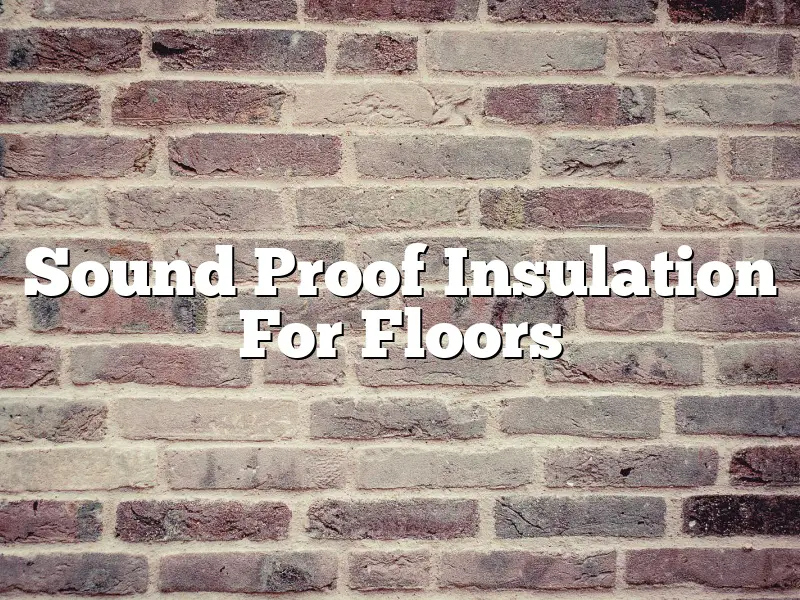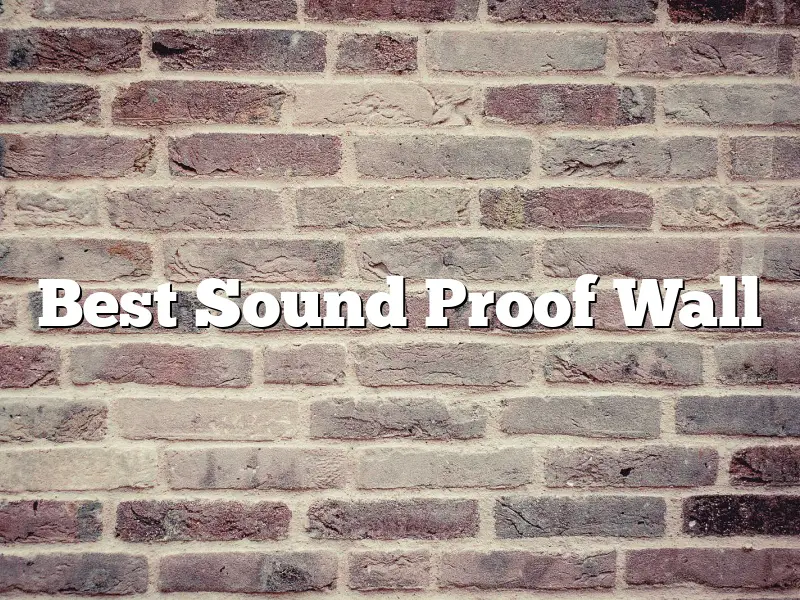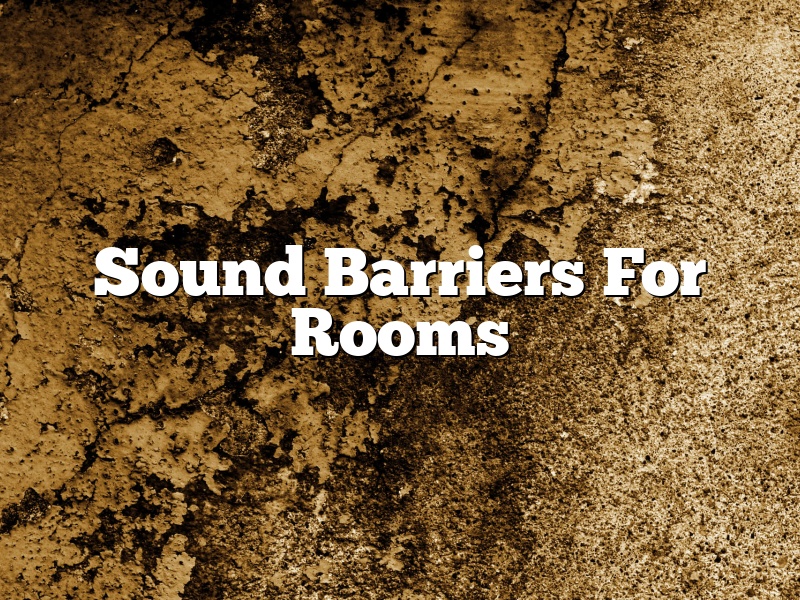There are many reasons why someone might want to sound proof their floors. Maybe they live in an apartment and they can hear their neighbors walking and talking. Maybe they have a home office and they don’t want their coworkers to be able to hear them typing. Or maybe they just want to keep the noise of their children and pets from bothering their downstairs neighbors.
No matter what the reason, there are a few different things that can be done to sound proof floors. The most common way to sound proof floors is to add some type of insulation between the floor and the subfloor. This will help to absorb the noise and keep it from traveling through the floor.
Another way to sound proof floors is to install a soundproofing membrane. This is a thin sheet of material that is installed over the floor. It will help to absorb the noise and keep it from traveling through the floor.
There are also a few different flooring options that can help to sound proof floors. Cork flooring is a good option because it is a natural material that absorbs sound. Another option is to install a floor made of rubber or foam. These materials are also good at absorbing sound.
If you are looking to sound proof your floors, there are a few different things that you can do. The most common way to sound proof floors is to add insulation between the floor and the subfloor. You can also install a soundproofing membrane over the floor. And finally, you can choose a flooring material that is good at absorbing sound.
Contents
- 1 How can I make my floors soundproof?
- 2 What is the best way to insulate for sound between floors?
- 3 How can I soundproof my floors cheap?
- 4 What insulation is best for soundproofing?
- 5 How do I soundproof my upstairs floor?
- 6 How do I stop walking noise upstairs floors?
- 7 How do you soundproof an upstairs floor?
How can I make my floors soundproof?
There are various ways that you can make your floors soundproof. Below are some of the most common methods:
1. Add a layer of insulation: Adding a layer of insulation can help to prevent sound from traveling through your floors. You can either add insulation on top of your current flooring or install it underneath your flooring.
2. Install a soundproofing membrane: A soundproofing membrane is a thin sheet of material that is installed between the floor and the subfloor. This can help to reduce the amount of sound that travels through your floors.
3. Use soundproofing pads: Soundproofing pads are placed between the floor and any furniture or equipment that you have on the floor. This can help to reduce the amount of sound that is transmitted through the floor.
4. Add a soundproofing layer to your flooring: If you are installing new flooring, you can add a soundproofing layer to your flooring. This will help to reduce the amount of sound that is transmitted through the floor.
5. Use a soundproofing sealant: A soundproofing sealant is a sealant that is used to seal any cracks or openings in your floor. This can help to reduce the amount of sound that travels through the floor.
6. Use a soundproofing rug: A soundproofing rug is a rug that is designed to reduce the amount of sound that is transmitted through the floor.
If you are looking to soundproof your floors, there are a number of different methods that you can use. Choose the method that is best suited for your needs and budget.
What is the best way to insulate for sound between floors?
There is no one definitive answer to the question of how to best insulate for sound between floors. Different methods will work better or worse in different situations, so it’s important to tailor the insulation to the specific needs of the building.
Some of the most common methods of soundproofing between floors include:
– Adding insulation between the floor joists
– Installing a soundproofing membrane between the floors
– Putting down a sound-deadening layer of carpet or padding
Each of these methods has its own advantages and disadvantages, so it’s important to choose the right one for the specific situation.
Adding insulation between the floor joists is the most common and affordable way to soundproof between floors. It is a relatively simple process, and it can be done with either fiberglass insulation or cellulose insulation. However, this method only works if there is enough space between the floor joists to fit the insulation.
Installing a soundproofing membrane between the floors is a more expensive option, but it can be more effective than adding insulation. A soundproofing membrane will help to prevent sound from traveling through the floor joists and into the floor below.
Putting down a sound-deadening layer of carpet or padding is another option that can be effective in some situations. This method can help to deaden the sound that travels through the floor, but it is not always practical or affordable.
In order to choose the best method of soundproofing between floors, it is important to consider the specific needs of the building. Factors that should be considered include the type of flooring, the construction of the building, and the budget.
How can I soundproof my floors cheap?
There are a few ways that you can soundproof your floors cheaply. One way is to add a rug or carpet to your floor. This will help to muffle the sound and make it less likely to travel through the floor and into other rooms. If you don’t want to add a rug or carpet, you can try adding some soundproofing materials to your floor. This could be anything from foam to rubber mats. These materials will help to absorb the sound and keep it from travelling through the floor. Finally, you can try sealing any cracks or crevices in your floor. This will help to prevent sound from travelling through them and into other rooms.
What insulation is best for soundproofing?
There are many factors to consider when choosing insulation for soundproofing. The most important factor is the type of sound you are trying to block. There are three types of sound: airborne sound, impact sound, and structure-borne sound.
Airborne sound is the easiest type of sound to block with insulation. It is created by sound waves that travel through the air. The best insulation for blocking airborne sound is high-density foam.
Impact sound is created when two objects collide. The best insulation for blocking impact sound is a dense material with a lot of mass, such as concrete or lead.
Structure-borne sound is created by sound waves that travel through the structure of a building. The best insulation for blocking structure-borne sound is a material that dissipates sound energy, such as rubber or fiberglass.
When choosing insulation for soundproofing, it is important to consider the type of sound you are trying to block, the density of the insulation, and the thickness of the insulation.
How do I soundproof my upstairs floor?
There are a few things you can do to soundproof your upstairs floor.
One option is to add a rug or carpet. This will help to absorb some of the noise. You can also add insulation between the floorboards to help reduce noise transmission.
Another option is to install a soundproofing membrane. This is a thin layer of material that is installed between the floor and the ceiling. It helps to block noise from passing through the floorboards.
Finally, you can install acoustic panels or insulation in the ceiling. This will help to absorb noise that is transmitted through the floor.
If you are having trouble deciding which option is best for you, consult a professional. They can help you choose the right products and installation methods to achieve the best results.
How do I stop walking noise upstairs floors?
There are a few ways that you can stop walking noise upstairs floors. One way is to install a new flooring material that is more sound-absorbent, such as carpet or cork. You can also add rugs or runners on top of your existing flooring to help reduce the noise. If you have hardwood floors, you can place felt pads or rug pads under your furniture to minimize the noise. Finally, you can install floor insulation to help reduce the sound transmission.
How do you soundproof an upstairs floor?
There are a few things you can do to soundproof an upstairs floor. One is to add a rug or carpet to the floor. This will help to muffle the sound. Another is to add insulation to the floor. This will help to dampen the sound. You can also add soundproofing panels to the floor. These panels will help to absorb the sound.





